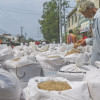Price woes for rice growers
Although paddy farmers are poised to get a bigger harvest this year, low prices have sapped their joy in the 10 south-western districts of the country.
The amount of paddy the government plans to buy directly from farmers would not help them much as well, they said while talking to The Daily Star yesterday.
In the 10 districts, Boro paddy was grown on 6.25 lakh hectares of land this year. It was 6.23 lakh hectares last year. The amount of harvest they expect is about 40 lakh tonnes, 60,000-70,000 tonnes higher than last year, said officials.
“Harvest has been good so far, but we are not going to reap the benefit because of low prices,” said Asadur Rahman, a farmer of Kushtia’s Khoksa upazila. “We’re frustrated.”
According to farmers, per maund of paddy is selling for Tk 580-850, based on the variety, while they expect the price to be Tk 1,200-1,350.
Mosarraf Hossain, a farmer of Gangni upazila in Meherpur, said paddy cultivation is less profitable than other crops. “All sorts of expenses are on the rise.”
Echoing him, farmer Asad said paddy farming is costlier, but it rakes in lower profits. “If I had cultivated maze, I would have Tk 30,000-35,000 in profit.”
Ramesh Chandra Ghosh, an upazila agriculture officer of Department of Agricultural Extension (DAE) in Kushtia, said farmers spent Tk 15,000 to Tk 15,850 per bigha, but they are earning about Tk 19,000 to Tk 19,450.
Although the government’s buying price is Tk 980-1,040, farmers are not happy.
The government would procure only 1 lakh tonnes in the 10 districts, according to Nitya Ranjan, additional director of Jashore regional agriculture office.
He said most farmers have cultivated high yielding varieties this year, and production is good. Production per hectare averages 6.5 tonnes, he added.
The price remains low because rice mill owners are not showing much interest in buying paddy.
“They are showing a sort of reluctance from the very beginning of harvesting,” said Liakat Ali, a middleman who connects farmers and rice mill owners in Khajanagar in Kushtia. “It’s a tactic we use to keep the price low,” he said.
Khajanagar is a regional rice hub with around 250 rice mills.
Liakat said, “Farmers would never get the benefit if the system is not changed. The government has to compel mill owners to give a fair price to farmers.”
Agriculture officials said farmers should not rush. “They should wait for some days after the harvest is complete. Then they should go for sale,” said Sushanta Kumar Pramanik, acting deputy director of DAE in Kushtia.
He said 60 percent of the harvest has been done so far.
Local administrative officials said they are setting up one buying centre in each upazila of the 10 districts to procure rice directly from farmers.

 For all latest news, follow The Daily Star's Google News channel.
For all latest news, follow The Daily Star's Google News channel. 








Comments